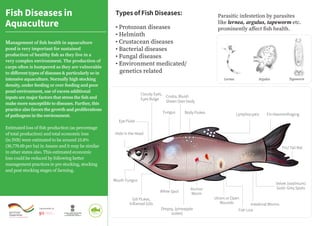1.-Fish-Diseases.pdf
- 1. Types of Fish Diseases: Parasitic infestetion by parasites like lernea, argulus, tapeworm etc. prominently affect fish health. Management of fish health in aquaculture pond is very important for sustained production of healthy fish as they live in a very complex environment. The production of carps often is hampered as they are vulnerable to different types of diseases & particularly so in intensive aquaculture. Normally high stocking density, under feeding or over feeding and poor pond environment, use of excess additional inputs are major factors that stress the fish and make more susceptible to diseases. Further, this practice also favors the growth and proliferations of pathogens in the environment. Estimated loss of fish production (as percentage of total production) and total economic loss (in INR) were estimated to be around 10.8% (30,770.00 per ha) in Assam and it may be similar in other states also. This estimated economic loss could be reduced by following better management practices in pre stocking, stocking and post stocking stages of farming. Lernea Argulus Tapeworm Eye Fluke Cloudy Eyes, Eyes Bulge Hole in the Head Fungus Mouth Fungus Gill Flukes, Inflamed Gills White Spot Anchor Worm Fish Lice Intestinal Worms Velvet (oodinium) Gold- Grey Spots Ulcers or Open Wounds Dropsy, (pineapple scales) Costia, Bluish Sheen Over body Body Flukes Lymphocystis Fin Haemorrhaging Fin/ Tail Rot Fish Diseases in Aquaculture âĒ Protozoan diseases âĒ Helminth âĒ Crustacean diseases âĒ Bacterial diseases âĒ Fungal diseases âĒ Environment medicated/ genetics related
- 2. General Causes for Fish Diseases âĒ Fish seed with low genetic immunity âĒ Malnutrition due to under-feeding. âĒ Deteriorated water and sediment conditions favouring fast spread of pathogens. âĒ Overcrowding pond with very high stocking density resulting stress and physical injuries leading to secondary infection. âĒ Infected fish seed, equipment, feed, birds & other external sources. âĒ Biosecurity lapses. âĒ Presence of Mollusc/Snail in fishery tank Managing Fish Diseases âĒ A sound health management program requires good management practices at all stages of aquaculture operations. âĒ Treating a diseased fish in isolation is difficult unlike land animals, & hence, prevention is always the best approach in aquaculture to control the disease outbreak than treating the disease. âĒ Prophylactic measures specially during winter months like maintaining water total alkalinity, proper water depth, avoiding over feeding will help in managing of fish health. Causes for Fish Mortality Treatment Strategies âĒ Knowledge on the disease development process, pathogens, the host & about the fish environment is very important for developing treatment strategies & health management in pond aquaculture. âĒ If only few individuals are affected & can be isolated, they can be treated individually & avoid further spreading. âĒ In most cases pond treatment is practiced for mass treatment of all the fishes. Biosecurity Measures âĒ Bio security is a set of management practices, which reduce the potential for the introduction, and spread of disease-causing organisms into and between sites. âĒ Bio-security procedures, particularly disinfection and sanitation, should be combined with selection of pathogen-free seed and strategic treatments to either eradicate or reduce these pathogens to non-infectious levels. âĒ Proper quarantine of stocks, isolation of affected stocks, personal hygiene, control of movement of people are essential biosecurity measures. âĒ Bio-fencing is also a method of biosecurity measure. Maintain required water depth (5-7 ft) at all times Clean excess aquatic plants & weed Clean off branches over the pond Clean algae blooms from the pond Reduce feeding during excessive rain & winter Cover pond with a net to avoid bird predation & bird faecal droppings Provide a net fence around the pond to prevent entry of predators Provide a foot-bath facility at entrance of the farm Parasitic infestation Alternation in water Bacterial diseases Other factors 24% 46% 22% 8%

